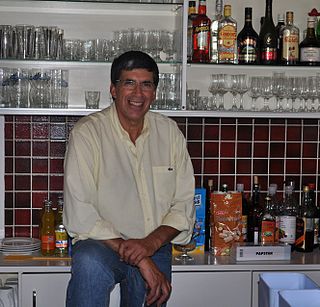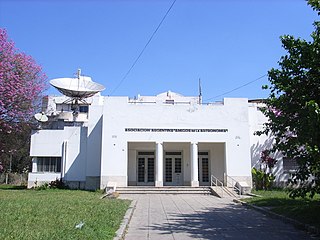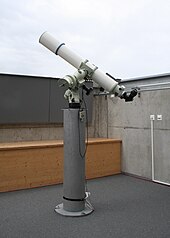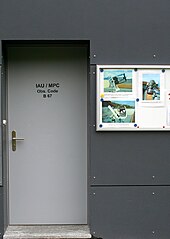
Lowell Observatory Near-Earth-Object Search (LONEOS) was a project designed to discover asteroids and comets that orbit near the Earth. The project, funded by NASA, was directed by astronomer Ted Bowell of Lowell Observatory in Flagstaff, Arizona. The LONEOS project began in 1993 and ran until the end of February 2008.
Wolf Bickel is a German amateur astronomer and a prolific discoverer of asteroids, observing at his private Bergisch Gladbach Observatory, Germany. He is the most successful German discoverer of minor planets.
Pierre Antonini is a retired French mathematics professor and amateur astronomer who has discovered several minor planets and two supernovae at his private Observatoire de Bédoin located at Bédoin, southeastern France. For many of his discoveries he used a 16-cm telescope or a 30-cm telescope.
11264 Claudiomaccone (provisional designation 1979 UC4) is a stony background asteroid and binary system from the middle regions of the asteroid belt, approximately 3 kilometers in diameter. It was discovered 16 October 1979, by Nikolai Chernykh at Crimean Astrophysical Observatory in Nauchnyj, on the Crimean peninsula. It was named after the Italian astronomer Claudio Maccone.
James Whitney Young is an American astronomer who worked in the field of asteroid research. After nearly 47 years with the Jet Propulsion Laboratory at their Table Mountain Facility, Young retired July 16, 2009.
1994 Shane, provisional designation 1961 TE, is a dark Adeonian asteroid from the central region of the asteroid belt, approximately 25 kilometers in diameter.
3673 Levy, provisional designation 1985 QS, is a binary Flora asteroid from the inner regions of the asteroid belt, approximately 6 kilometers in diameter. It was discovered on 22 August 1985, by American astronomer Edward Bowell at Lowell's Anderson Mesa Station near Flagstaff, Arizona, United States. The asteroid was named after Canadian astronomer David H. Levy.
4007 Euryalos is a larger Jupiter trojan from the Greek camp, approximately 48 kilometers in diameter. It was discovered on 19 September 1973, by Dutch astronomers Ingrid and Cornelis van Houten at Leiden, and Tom Gehrels at Palomar Observatory in California. The likely spherical Jovian asteroid is the principal body of the proposed Euryalos family and has a rotation period of 6.4 hours. It was named after the warrior Euryalus from Greek mythology.
7816 Hanoi, provisional designation 1987 YA, is an eccentric stony asteroid and Mars-crosser from the inner regions of the asteroid belt, approximately 3 kilometers in diameter. It was discovered on 18 December 1987, by Japanese astronomer Masahiro Koishikawa at the Ayashi Station of the Sendai Astronomical Observatory, Japan, and later named after the Vietnamese capital of Hanoi.
11132 Horne is a Hygiean asteroid from the outer regions of the asteroid belt, approximately 13 kilometers in diameter. It was discovered on 17 November 1996, by American amateur astronomer Dennis di Cicco at his Sudbury Observatory in Massachusetts, United States. The asteroid was named for Johnny Horne, photo editor of The Fayetteville Observer.
2726 Kotelnikov, provisional designation 1979 SE9, is a stony Koronian asteroid from the outer regions of the asteroid belt, approximately 10 kilometers (6.2 miles) in diameter. It was discovered on 22 September 1979, by Soviet astronomer Nikolai Chernykh at the Crimean Astrophysical Observatory in Nauchnij on the Crimean peninsula. The S-type asteroid has a rotation period of 4.91 hours and is a suspected binary system. The asteroid was named for Soviet scientist and pioneer in radar astronomy, Vladimir Kotelnikov.
2577 Litva, provisional designation 1975 EE3, is a Hungarian-type Mars-crosser and rare trinary asteroid from the inner regions of the asteroid belt, approximately 4 kilometers in diameter.
1936 Lugano, provisional designation 1973 WD, is a carbonaceous Adeonian asteroid from the middle region of the asteroid belt, approximately 26 kilometers in diameter.
15415 Rika, provisional designation 1998 CA1, is a bright background asteroid from the Florian region of the inner asteroid belt, approximately 3 kilometers (2 miles) in diameter. It was discovered on 4 February 1998, by Japanese astronomer Akimasa Nakamura at the Kuma Kogen Astronomical Observatory in southern Japan. The presumed S-type asteroid has a rotation period of 6.36 hours and possibly an elongated shape. It was named after Rika Akana, a character in the Japanese film and later television adapted drama Tokyo Love Story.
5010 Amenemhêt is a stony asteroid from the central region of the asteroid belt, approximately 9 kilometers in diameter.

Observatory Robert A. Naef is an astronomical observatory located at Épendes, Canton of Fribourg, Switzerland at 7.13938 degrees east of Greenwich and 46.76236 degrees north latitude. Its parallax constants are : ρ sin φ' = 0.68632 and ρ cos φ' = +0.72501.

José De Queiroz is a Portuguese-born, Swiss amateur astronomer and discoverer of minor planets, as well as a restaurant manager in Falera in the Swiss canton of Graubünden.
6250 Saekohayashi, provisional designation 1991 VX1, is a bright Hungaria asteroid and relatively slow rotator from the inner regions of the asteroid belt, approximately 3.7 kilometers in diameter. It was discovered on 2 November 1991, by American astronomer Eleanor Helin at Palomar Observatory in California, and later named after Japanese astronomer Saeko Hayashi.

Asociación Argentina Amigos de la Astronomía is an amateur astronomy civil association based on Buenos Aires, Argentina, with the aim of spreading astronomy. It was founded on January 4, 1929 and its field courses are held on related subjects, research in collaboration with professional bodies and printed publications or multimedia, and recreational activities for the general public. The main-belt asteroid 4756 Asaramas was named in honor of the observatory.









